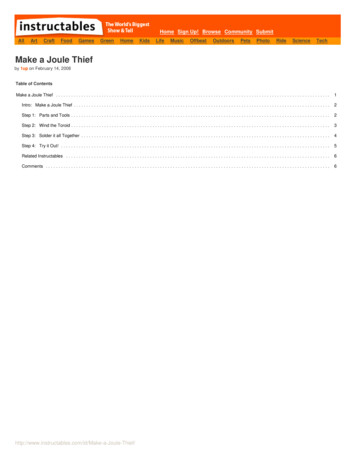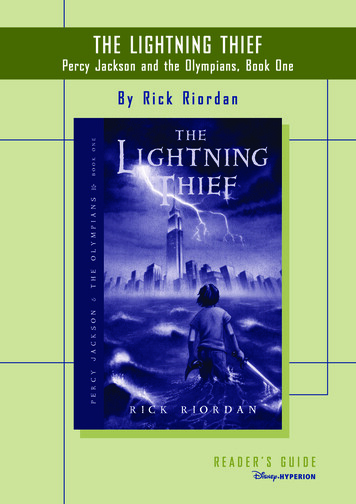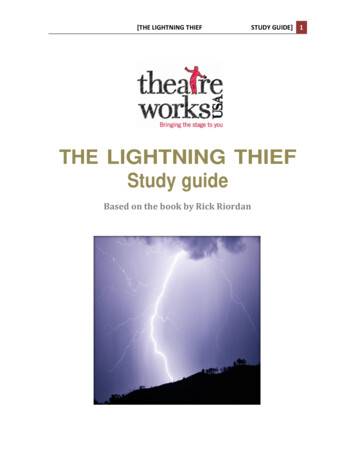
Transcription
Home Sign Up! Browse Community fbeatOutdoorsPetsPhotoRideScienceTechMake a Joule Thiefby 1up on February 14, 2008Table of ContentsMake a Joule Thief . . . . . . . . . . . . . . . . . . . . . . . . . . . . . . . . . . . . . . . . . . . . . . . . . . . . . . . . . . . . . . . . . . . . . . . . . . . . . . . . . . . . . . . . . . . . . . . . . . . . . . . . . . . .1Intro: Make a Joule Thief . . . . . . . . . . . . . . . . . . . . . . . . . . . . . . . . . . . . . . . . . . . . . . . . . . . . . . . . . . . . . . . . . . . . . . . . . . . . . . . . . . . . . . . . . . . . . . . . . . . . .2Step 1: Parts and Tools . . . . . . . . . . . . . . . . . . . . . . . . . . . . . . . . . . . . . . . . . . . . . . . . . . . . . . . . . . . . . . . . . . . . . . . . . . . . . . . . . . . . . . . . . . . . . . . . . . . . . .2Step 2: Wind the Toroid . . . . . . . . . . . . . . . . . . . . . . . . . . . . . . . . . . . . . . . . . . . . . . . . . . . . . . . . . . . . . . . . . . . . . . . . . . . . . . . . . . . . . . . . . . . . . . . . . . . . . .3Step 3: Solder it all Together . . . . . . . . . . . . . . . . . . . . . . . . . . . . . . . . . . . . . . . . . . . . . . . . . . . . . . . . . . . . . . . . . . . . . . . . . . . . . . . . . . . . . . . . . . . . . . . . . .4Step 4: Try it Out! . . . . . . . . . . . . . . . . . . . . . . . . . . . . . . . . . . . . . . . . . . . . . . . . . . . . . . . . . . . . . . . . . . . . . . . . . . . . . . . . . . . . . . . . . . . . . . . . . . . . . . . . . .5Related Instructables . . . . . . . . . . . . . . . . . . . . . . . . . . . . . . . . . . . . . . . . . . . . . . . . . . . . . . . . . . . . . . . . . . . . . . . . . . . . . . . . . . . . . . . . . . . . . . . . . . . . . . . .6Comments . . . . . . . . . . . . . . . . . . . . . . . . . . . . . . . . . . . . . . . . . . . . . . . . . . . . . . . . . . . . . . . . . . . . . . . . . . . . . . . . . . . . . . . . . . . . . . . . . . . . . . . . . . . . . . . ef/
Author:1up ModRetroSometimes my Instructables are few and far between, but I try to make them as well as I can. Hopefully you can be inspired or helped by the content in them!Intro: Make a Joule ThiefYes, it's the infamous Joule Thief, in Instructable form! For those of you who don't know, the Joule Thief is a tiny little circuit that allows you to drive a white or blue LEDfrom voltages as low as 0.5 volts. You think those batteries are dead? Don't throw them out yet! Hook them up to the Joule Thief to squeeze every last drop of energy outof them!The idea and circuit came from this Make weekend project. Why don't you pay them a visit?Step 1: Parts and ToolsFor this project you will need very few tools and parts, as you will see in the picture below.But for those of you who like it in text, here it is:Helping Hands (Optional)Soldering IronSolderA Blue or White LED (Other colors are fine, too)2N3904 Transistor or equivalent1k Resistor (Brown-Black-Red)Toroid BeadThin wire, two colors (magnet wire works)You can get the toroid and transistor from a dead CFL; the transistor is usually labeled 13002.Also, if you use a 2N4401 or BC337 transistor, your LED will be brighter because they can handle more amps.Image Thief/
1. Thin wire, at least two colors2. Blue LED3. 2N3904 NPN Transistor4. 1k Resistor (Color code Brown-Black-Red)5. Toroid Bead6. Helping Hands (Optional, but really useful in any project)7. Rosin-Core Solder8. Soldering IronStep 2: Wind the ToroidThe first step is to wind the toroid. I found mine in an old computer power supply, and it works fine for me. Toroids are donut-shaped objects like in the picture, and can beattracted by a magnet.You can find toroids in a few places. Old computer motherboards, XBOX and X360 motherboards have them (don't take them unless it's dead!). You can find toroids incomputer power supplies, or you could buy them at your nearest RadioShack.Take your two strands of wire, and twist the ends together. You don't have to do this, but it makes winding a little easier.Thread the twisted end through the toroid, then take the other two ends (Not twisted together) and wind it once around the toroid. Don't twist the wires; make sure thattwo wires of the same color are not right next to each other.Keep winding, making sure you wind the coils tight. It will still work if they are kind of loose, but it is better to have them tight.Ideally, you want about 8-11 turns on your toroid. Even if you can fit more, don't put more on. Make sure the turns are spaced evenly around the toroid.Once you wind around the whole toroid, cut off the extra wire, making sure you leave a couple of inches for soldering.Strip some insulation off the wires, then take a wire from each side, making sure they are of the OPPOSITE COLOR. Twist them together, and then you're done with thetoroid.Image Notes1. Put the wires through the center.Image Notes1. Wrap it around.Image Notes1. Halfway there.Image Notes1. Finished toroid, with wires of the OPPOSITE COLOR from DIFFERENT Thief/
twisted together.Step 3: Solder it all TogetherNow we are going to solder the whole thing together. You could put it on a board if you like, but in this Instructable, we're going to free-hand solder it. Or whatever youcall it. You can follow these written instructions, or take a look at the pictures. They explain it very well.First, take the two outer leads of the transistor and bend them outwards a little ways, and bend the middle lead backwards. Bend the LED's leads outwards, too. Youdon't have to, but it makes it easier to solder.Take one of the wires coming from the toroid that is alone; that is, not twisted together with another wire. Solder it to one side of the resistor. Solder the other end of theresistor to the middle lead of the transistor.Take the other single wire from the toroid, and solder it to the collector of the transistor. Solder the positive side of the LED to the collector as well, and solder thenegative side to the emitter.All that's left to do now is solder an extension wire to the negative side of the LED. Take a piece of that wire you had earlier and solder it to the transistor's emitter.Image Notes1. Collector2. Emitter3. hief/
Image Notes1. The negative side of the LED has a shorter lead.Step 4: Try it Out!And that's it! You're finished with your Joule Thief. Touch the twisted wires coming from your toroid to the positive side of a battery, and the extension wire to the negativeside. If all is working well, the LED will light up! If not, try using thinner wire on your toroid. I've included a schematic in the pictures if you e-Thief/
Related InstructablesJoule ThiefCharger bybotronicsUltraviolet LightPen by junits15Dollar StoreJoule Thief! byaromaoftacomaElectric ChairJoule Thief byFockerJoelThe illuminated the joule thiefLED man (or(Photos) byThe Joule Thiefjaybird0123man) (Photos) bySpEcIeS8472Comments50 comments Add Commentview all 586 commentsbatman96 says:Mar 18, 2011. 11:16 AM REPLYI just rebuilt the one I built a wile ago that didn't work and it works now, I am trying to decide to build a "dead battery flashlight" or a "dead battery night light"Turns out the transistor I had was either broken or pnp. I got a bread board so I just tried different transistors until it worked.Thanks for the very detailed instructions!chris28456 says:Mar 12, 2011. 9:24 PM REPLYGreat Project. Anyone know what gauge (awg) wire is suggested? also solid core vs. stranded does it matter? ThanksShemySheza says:Mar 6, 2011. 5:24 AM REPLYthanks but 1 question-how many wounds of wire?just 10 or can i use more?does it matter?lperkins says:Mar 5, 2011. 10:55 PM REPLYIt's perfectly possible to solder to batteries without any ill-effects. Commercial battery packs use spot-welding, and you want the heat characteristics to be asclose to that as possible. Basically you want a high-power soldering gun. One of those little pencil irons is not going to cut it. In my experience, a good rule ofthumb is to never put your iron to the battery for more than about two seconds, and then let it cool completely first if you have to hit it again. If you can'tmake it work that fast, you need a hotter iron. I can only speak for Alkaline, NiCd, and NiMh batteries. I wouldn't even try to solder things with "Lithium"anywhere in the name without good safety gear and a fume hood.Indula says:Jan 29, 2011. 11:27 PM REPLYcan we use button cell1up says:Feb 3, 2011. 6:43 PM REPLYSure, but don't solder to it. I can almost guarantee you it will explode.Gepetto Father says:Mar 3, 2011. 6:28 AM REPLYi've soldered button cells many times with no explosions involved. What does happen is the fast oxidation of the metal case, specially where i sand toget a cleaner sodering surface.Of course, don't take too much time soldering it or it really might explode. Other thing to note is that they stay hot for like, centuries, after you heatthem.robot1398 says:Feb 21, 2011. 5:20 AM REPLYi made it and it works very well.i used a bc547 transistorcool projectrobot1398 says:Dec 26, 2010. 7:21 AM REPLYcan i use a bc547 transistor in place of 2n3904robot797 says:all npn transistors workwhen i build onei get my junk box and desolder the firsth npn i see :Palso if you make the 1K resistor a 2 or 5 K pot you can tune it into the right oule-Thief/Dec 26, 2010. 2:20 PM REPLY
robot1398 says:Feb 21, 2011. 3:19 AM REPLYthanksspartans says:Feb 18, 2011. 9:41 AM REPLYas the transistor turns on and off quite frequently wont it damage the LED being used.Munchys says:Feb 16, 2011. 6:29 PM REPLYMy led requires 3.5v this wouldn't be able to power it would it?Musicman41 says:Jan 19, 2011. 11:46 AM REPLYwhat is the purpose of the toroid?JoshuaZimmerman says:Jan 24, 2011. 7:28 AM REPLYWire wrapped in a coil creates a magnetic field when power flows through them (thats how electric motors work). In this case we get a magnetic fieldbuilding up in the coil, when the transister switches the field collapses and the extra power it's build up gets flooded into the circuit. This then happenslike 1000 times a second. This is how we're able to power a 3.6 volt LED off a 1.5 volt battery. To directly answer your question the toroid is justsomething for you to wrap your wires around, anything will do. I love using this circuit in combination with a solar panel to build weird solar lights. (I evenhave kits available for it on my website, browndoggadgets.com)Munchys says:Feb 13, 2011. 7:30 PM REPLYSo could I use a super magnet with a hole in the middle instead of a toroid?JoshuaZimmerman says:Feb 13, 2011. 9:46 PM REPLYJust use a toroid. Or anything round really. A magnet might cause all sorts of issues, and be a big pain to work with around all these metal parts.PatrickVallieres says:Feb 4, 2011. 6:52 PM REPLYi us a button cell and a hollther from a old computer and a micro swechaxeman911 says:Jan 22, 2011. 12:39 PM REPLYwhats a toroid what is its purpose?rayfalcon says:Nov 21, 2010. 6:20 AM REPLYhey it works kind of! let me explain whats going on it blinks my led but will not keep it lit up and my battery gets extremely Hot so i quit using the one i justmade and taking some time to try and get help on itthe 1 k trans might be wrong on mine its a clear glass thing with Brown black and red on it but its glassand on one side it says 48 thats all it has on it.Is that a 1k trans or is this a diode? if so can that be the problem?Charles1up says:Nov 21, 2010. 9:49 PM REPLYIt's a diode if it's glass. :P Look up some diodes and resistors on Google images so you can tell the difference.kcarring says:Jan 7, 2011. 12:39 AM REPLY maybe it is a 1n4147 diode. resister shouldn't be glass. if it looks like this: http://tinyurl.com/27l63z6 it's a diodethomas53 says:Dec 21, 2010. 7:25 AM REPLYWorks perfectly :)rhanson294 says:Dec 1, 2010. 8:07 PM REPLYNot to be offensive, but I have always been told that you never solder to a battery. In some of the pictures it looks like the wire is soldered directly to thebattery. Just wondering how safe that ief/
luiscll says:Dec 6, 2010. 12:56 PM REPLYI think that with a pair of magnets the soldering can be avoided. Just an idea to who wants to avoid soldering.thomas53 says:Dec 21, 2010. 7:24 AM REPLYOr just use a battery holderthreewheela says:Dec 4, 2010. 10:29 PM REPLYits plenty safe as long as you dont overheat the battery because it could explode and everyone knows heat is bad for battery life anyway1up says:Dec 2, 2010. 7:07 PM REPLYIt does looks like that. I actually slid the wire under the plastic cover on the battery to hold it in place, and the bottom wire is just being sat on by thebattery.You are right, you should never try to solder to batteries.beehard44 says:Dec 2, 2010. 4:11 AM REPLYjust do it quickly and never using a button cellrobot1398 says:Dec 18, 2010. 7:11 PM REPLYhow thick wire we have to use to wind on the toroidscraptopower says:Dec 9, 2010. 1:47 PM REPLYIf you've built this and it doesn't work, try reversing one of the phases on the toroid. I built two neither of which worked. I read on another site that if it doesn'twork but is drawing current (mine drew 50ma without lighting the LED) then one of the phases of the toroid must be the wrong way around. Now it draws39ma and lights up the LED!So I reversed one phase in both of my joule thieves, and they work brilliantly now! The LED is blinding!Thanks for the great instructable!batman96 says:Dec 15, 2010. 10:41 AM REPLYI got Joule Thief I built that doesn't work, every part is good, I got a multimeter, how do I check if it is drawing any current? And if it is how do I "Tryreversing one
anywhere in the name without good safety gear and a fume hood. Indula says: Jan 29, 2011. 11:27 PM REPLY can we use button cell 1up says: Feb 3, 2011. 6:43 PM REPLY Sure, but don't solder to it. I can almost guarantee you it will explode. Gepetto Father says: Mar 3, 2011. 6:28 AM REPLY











